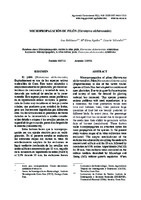Micropropagación de Pilón (Hieronyma Alchorneoides)

Fecha
2011Autor
Abdelnour-Esquivel, Ana
Valverde, Lissette
Aguilar, Mª Elena
Metadatos
Mostrar el registro completo del ítemResumen
El pilón (Hieronyma alchorneoides, Euphorbiaceae) es una de las especies nativas maderables de Costa Rica mejor adaptadas a condiciones abiertas de plantación; por sus características de crecimiento y variedad de usos, la demanda por material de siembra se ha incrementado. Esta especie presenta serios problemas en su reproducción sexual: es dioica, la producción de frutos muy variable en el tiempo y entre árboles, que producen gran cantidad de frutos, pero son fuertemente depredados por diferentes aves. En los últimos años el porcentaje de frutos dañados se ha incrementado a niveles considerables debido a avispas y las semillas pierden su capacidad de germinación pocos días después de la cosecha (recalcitrante). Estos factores hacen que la micropropagación sea una opción atractiva para su multiplicación. En el presente estudio se evaluaron las diferentes etapas del cultivo in vitro. El establecimiento aséptico de los embriones se logró mediante incubación de las semillas con ácido sulfúrico concentrado por 10 min, seguido de la inmersión en hipoclorito de sodio (NaOCl) al 5,5% durante 30 min; los embriones fueron inoculados en el medio de cultivo de Murashige y Skoog (MS) sin reguladores del crecimiento. La asepsia de material vegetativo se logró con cloruro de mercurio (HgCl2) al 0,095% por 5 min, el 50% de las microestacas que brotaron en el medio MS simple. Además, se observó que el pilón no requiere de la adición de reguladores del crecimiento en las etapas de brotación y multiplicación. El uso de 0,1 mg.l-1 de ácido indolbutírico (AIB) promovió el enraizamiento del 80% de los tallos y el número mayor de raíces por tallo (5,0) de buena calidad. Se logró un 70% de sobrevivencia en la aclimatación de las plantas en condiciones de invernadero. Pilon (Hieronyma alchorneoides) (Euphorbiaceae) is one of the native timber species of Costa Rica best adapted to conditions of open plantation. Due to its growth characteristics and variety of uses, the demand for planting material has increased. This species presents serious problems with seed reproduction; it is a dioecious, the fruit production varies over time and between trees, trees produce large quantities of fruit but are heavily predated by different birds. In recent years, the percentage of damaged fruit has increased due to wasps and the seeds lose their ability to germinate within days of harvest (recalcitrant).
These factors make micropropagation an attractive option for mass propagation of the species. In the present study various stages of in vitro cultivation were evaluated. The aseptic establishment of the embryos was achieved by scarifying the seeds with concentrated sulfuric acid for 10 min, followed by incubation in 5.5% sodium hypochloride (NaClO) for 30 min, then embryos were inoculated on the culture medium described by Murashige and Skoog (MS) without growth regulators. When vegetative material was used as initial explant, the use of 0.095% mercuric chloride (HgCl2) during 5 min, allowed 50% of cuttings to develop shoots under aseptic conditions on a simple MS medium. It was observed that pilon does not require the addition of growth regulators during bud induction nor in the multiplication stages.
During rooting, the addition of indole butyric acid (IBA) at concentrations of 0.1 mg.l-1 promoted the highest percentage of rooted shoots (80%), the largest number of roots per stem (5.0) and the best quality of the roots formed. Survival of in vitro plants after acclimation under greenhouse condition reached 70%.
Fuente
Agronomía Costarricense 35(2): 9-19.Compartir
Métricas
Colecciones
- Artículos [40]

